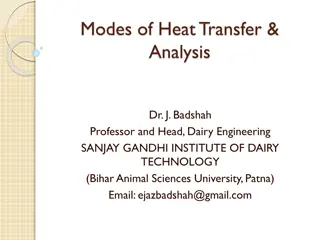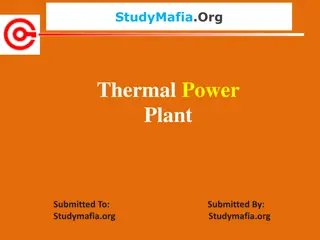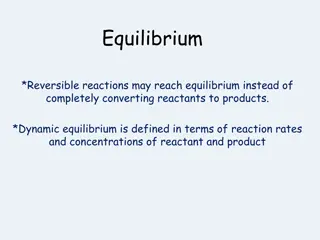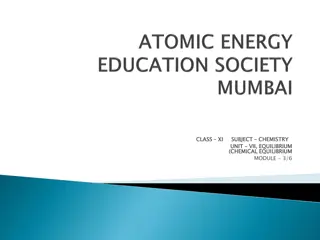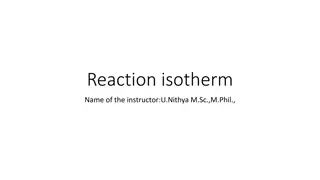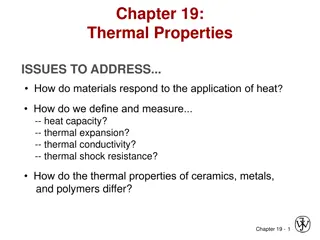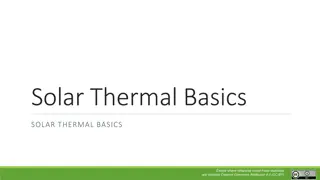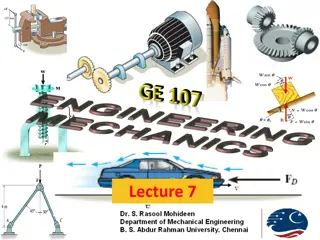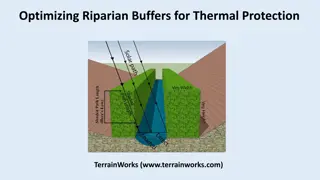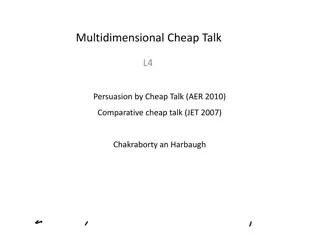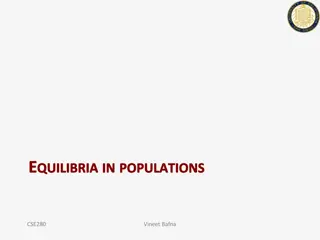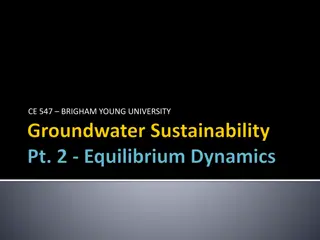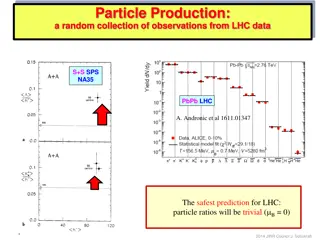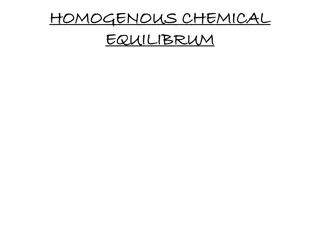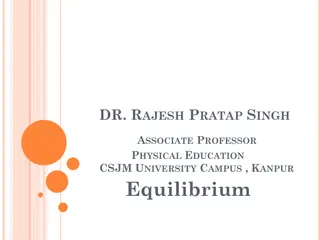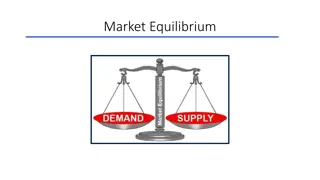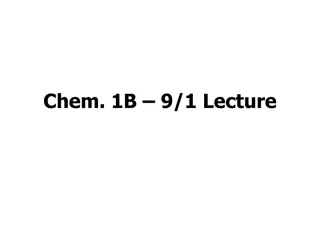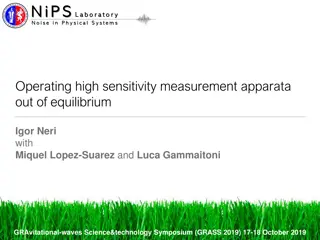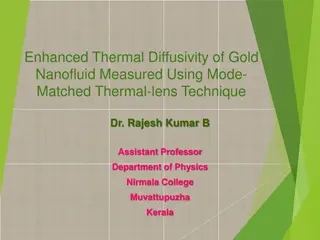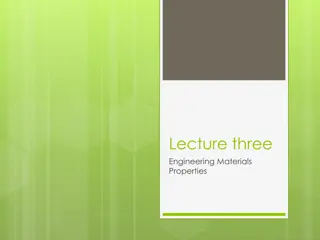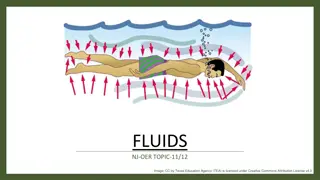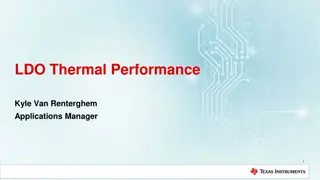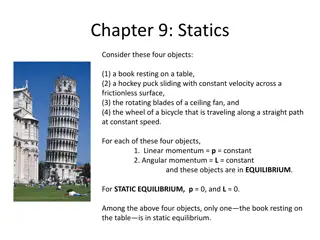Heat Transfer: Conduction, Thermal Conductivity, and More
Explore the fundamentals of heat transfer through conduction and thermal conductivity as explained by Dr. J. Badshah. Learn about the modes of heat transfer, Fourier's law, thermal resistance, and the relationship between thermal and electrical conductivity. Discover the essential features of therma
1 views • 9 slides
Equilibrium for Moving Objects
Objects can be in static equilibrium when at rest or dynamic equilibrium when moving at a constant speed. Equilibrium is maintained when there is no net force to change the state of motion. This equilibrium is possible when forces either cancel out or there is no force acting on the object. Friction
0 views • 8 slides
Thermal Power Plants: Overview and Operation
Thermal power plants play a crucial role in converting heat energy into electricity for various applications. This article covers the definition, layout, working principle, and components of thermal power plants, highlighting their advantages and top features. From converting heat into mechanical po
1 views • 20 slides
Chemical Equilibrium in Reversible Reactions and Laws
Chemical equilibrium in reversible reactions involves the balance between forward and backward reactions, as governed by laws like the law of mass action and the law of chemical equilibrium. These laws help in understanding the rates of reactions, equilibrium constants, and the relationship between
2 views • 12 slides
Dynamic Equilibrium in Chemical Reactions
Explanation of reversible reactions, dynamic equilibrium, and the characteristics of equilibrium in chemical systems. Covers the concept of reversible reactions, dynamic equilibrium, rules for dynamic equilibrium, and examples to illustrate these concepts visually.
0 views • 54 slides
Le Chatelier's Principle in Chemical Equilibrium
Le Chatelier's Principle states that when a system at equilibrium is disturbed by changes in concentration, temperature, or pressure, the equilibrium shifts to counteract the change. This principle can be applied to predict the direction of equilibrium when changes occur. Changes in concentration, p
0 views • 10 slides
Reaction Isotherms and Equilibrium Constants
Explore reaction isotherms and equilibrium constants through Vant Hoff's and Gibbs free energy equations. Learn about the relationship between Gibbs free energy, equilibrium constant, and temperature dependence. Discover how these concepts are applied in determining the direction of chemical reactio
3 views • 18 slides
Thermal Properties of Materials
Materials respond differently to heat based on their thermal properties such as heat capacity, thermal expansion, conductivity, and shock resistance. The ability of materials to absorb heat, expand with temperature changes, and conduct heat varies across ceramics, metals, and polymers. Heat capacity
1 views • 19 slides
Solar Thermal Technology Basics
This content covers the basics of solar thermal technology, including insolation, passive solar design, and active solar systems for producing hot water. It explains the uses of solar thermal energy in domestic, commercial, and pool heating applications. The efficiency of solar thermal panels compar
1 views • 13 slides
Equilibrium of Rigid Bodies: Moments, Couples, and Forces
The topic covers the equilibrium of rigid bodies with a focus on moments, couples, and forces. It discusses concepts such as moments of a force, Varignon's theorem, types of supports, and equilibrium in two and three dimensions. The equilibrium in two-force members and three-force members is explain
1 views • 23 slides
Consumer Equilibrium in Economics
Consumer equilibrium refers to the point where a consumer maximizes satisfaction by spending income on commodities. In single commodity case, equilibrium is achieved when marginal utility equals price. For two commodities, equilibrium is reached when the ratio of marginal utility to price is equal.
1 views • 7 slides
Free Energy, Reaction Quotient, and Equilibrium Constant
This educational material delves into the concepts of free energy, reaction quotients, and equilibrium constants in chemical systems. It explains how to determine the direction of a reaction based on Q and K values, elucidates the role of Gibbs free energy in determining spontaneity, and provides ca
0 views • 10 slides
Optimizing Riparian Buffers for Thermal Protection in Teanaway River Watershed
Explore the study comparing optimized riparian buffer designs with fixed-width buffers in non-fish bearing streams of the Teanaway River watershed, focusing on maximizing thermal energy reductions with considerations for channel orientation and forest density. By utilizing NetMaps and thermal energy
1 views • 24 slides
Chemical Equilibrium in Reversible Reactions
Chemical equilibrium occurs when the concentrations of reactants and products remain constant over time in a reversible reaction. Reaction rate is proportional to concentration, and equilibrium is reached when the rate of formation equals the rate of consumption in both directions. Reversible reacti
2 views • 25 slides
Heat Transfer and Thermal Insulation
Explore the concepts of heat transfer, thermal insulation, thermodynamic systems, temperature, and means of heat transfer. Learn about conduction, convection, and radiation and how they impact the equilibrium and transfer of thermal energy. Gain insights into designing containers to minimize heat lo
1 views • 30 slides
Insights into Persuasion and Equilibrium in Multidimensional Cheap Talk
Explore the dynamics of multidimensional cheap talk, focusing on sender-receiver interactions, influential equilibrium, welfare rankings, and fragility to asymmetries. Lessons touch on bubbling equilibrium, influential equilibrium issues, welfare rankings preferences, and the impact of asymmetric pr
1 views • 20 slides
Equilibria in Populations: Hardy-Weinberg Principle
Exploring the concept of equilibria in populations, focusing on Hardy-Weinberg principles and its implications. The discussion covers allele distributions, genotype frequencies, maintenance of equilibrium across generations, and scenarios where equilibrium may be violated. Key points include basic p
0 views • 58 slides
Groundwater Sustainability and Equilibrium Dynamics
This content delves into the concepts of groundwater sustainability, equilibrium, and capture in relation to groundwater management. It explores transitional storage, groundwater mining, and debunks the water budget myth. The images and explanations illustrate how pumping affects aquifers, the evolu
1 views • 11 slides
Insights into Particle Ratios and Equilibrium Dynamics at LHC
Collection of observations from LHC data regarding particle ratios and the successful Thermal Model. Discusses the concept of equilibrium, onset of equilibrium, relationship to QGP phase, and potential solutions through out-of-equilibrium studies. Also delves into size/volume dependence, strangeness
1 views • 11 slides
Homogenous Chemical Equilibrium
Homogenous chemical equilibrium occurs when reactants and products are in the same phase. This equilibrium remains independent of the volume of the reaction mixture. The concept is illustrated through the example of the Hydrogen-Iodide system and a generic reaction A + B --> 2C. Partial pressure pla
1 views • 56 slides
Insights into Non-equilibrium Kinetic Theory: Inhomogeneous Systems
Statistical averages in kinetic theory connect distribution functions to macroscopic properties like pressure and particle flux. When systems are inhomogeneous or away from equilibrium, local equilibrium breaks down, leading to slow relaxation processes towards global equilibrium. The evolution of p
0 views • 12 slides
Equilibriums in Physics
Equilibrium in physics refers to the state of a body where there is no change in translational or rotational motion. This state can be classified into static equilibrium (when total force and torque are zero) and dynamic equilibrium (when a body is in uniform motion with zero resultant force and tor
1 views • 9 slides
Market Equilibrium
Market equilibrium is achieved when the quantity demanded equals the quantity supplied at a specific price, ensuring a balance in the marketplace. Demand and supply schedules play a crucial role in determining market equilibrium, with excess supply or demand occurring when prices deviate from the eq
0 views • 12 slides
Game Abstraction and Equilibrium
Extensive-Form Game Abstraction with Bounds delves into the complexities of game abstraction, exploring theoretical guarantees, algorithmic challenges, and equilibrium-finding processes. The difficulty of game abstraction is examined, highlighting issues such as pathologies and the struggle to optim
1 views • 22 slides
Chemical Equilibrium in Chemistry
Exploring the concept of chemical equilibrium in chemistry, where reactions can occur in both forward and reverse directions to an appreciable extent. Learn about basic equilibrium principles, equilibrium problems, manipulating reactions, and common example problems in nomenclature. Understand how r
0 views • 24 slides
Operating high sensitivity measurement apparata out of equilibrium
Operating high sensitivity measurement apparata out of equilibrium presents challenges and opportunities in gravitational wave science and technology. This includes the exploration of equilibrium versus out-of-equilibrium conditions, previous attempts using external feedback, and an analysis of line
0 views • 16 slides
Friction and Equilibrium in Physics
Concepts of friction and equilibrium in physics, including definitions of forces like weight, tension, and reaction force. Learn about the relationship between friction force and reaction force, solving equilibrium problems, and the significance of limiting equilibrium. Find practical examples and c
0 views • 19 slides
Therminator: Thermal Simulator for Smartphones
Therminator is a thermal simulator designed to address the thermal challenges faced by smartphones due to their high power density and compact size. It produces accurate chip and skin temperature maps, aiding in optimizing thermal management strategies. The tool assists in designing the most appropr
0 views • 15 slides
Thermal Management Units, Measures, and Models
In this article, learn about thermal management units, measures, and models essential for engineers in the LED industry. Explore concepts like thermal conductivity, thermal resistance, and how to make informed decisions when selecting materials based on their thermal properties. Dive into calculatio
1 views • 16 slides
Finite Temperature Field Theory Basic
Delve into the realm of finite temperature field theory through a comprehensive exploration of basic methods, including generating functional for Green functions, partition function in equilibrium, path integral representation, and thermal Green functions. Discover the nuances of real-time and imagi
0 views • 33 slides
TFAWS Active Thermal Paper Session
This paper discusses the thermal gravitational scaling of similar fluids in active thermal systems. The authors present three example applications, highlighting the significance of dimensionless numbers in understanding fluid behavior under thermal influences. The study provides valuable insights in
0 views • 20 slides
Enhanced Thermal Diffusivity of Gold Nanofluid Measured Using Mode-Matched Thermal-lens Technique
This study by Dr. Rajesh Kumar B investigates the thermal diffusivity of gold nanofluid using advanced mode-matched thermal-lens technique. The research, conducted at Nirmala College in Kerala, sheds light on the enhanced thermal properties of gold nanoparticles in a fluid medium. The findings have
0 views • 12 slides
Analyzing Economic Events: Impact on Equilibrium Price and Quantity
In the field of economics, understanding how events affect demand, supply, and equilibrium is crucial for predicting market reactions. This content delves into scenarios where shifts in supply and demand curves result in changes to equilibrium price and quantity, leading to either shortages or surpl
0 views • 5 slides
Understanding Chemical Equilibrium in Chemistry Lectures
In these Chemistry lecture announcements, you will find information about exam coverage, lab data postings, calibration questions, and manipulating equilibrium reaction equations. The content covers topics such as statistical calculations, least squares regression, equilibrium equations from chemica
0 views • 19 slides
Understanding Engineering Material Properties - Mechanical, Thermal, and More
Explore the key properties of engineering materials, including mechanical characteristics like strength, stiffness, hardness, and toughness. Delve into thermal aspects such as heat capacity, thermal expansion, and thermal conductivity. Discover how materials respond to heat and the transfer of therm
0 views • 9 slides
Understanding Heat Transfer and Thermal Properties in Fluids
Explore concepts related to heat transfer, equilibrium temperature calculation, thermal conductivity, and more in fluids. Learn about the methods of heat transfer, convection, radiation power calculations, and the relationship between area, temperature, power, and emissivity. This educational materi
0 views • 15 slides
Understanding Thermal Performance Metrics in IC Design
Gain insights into the importance of JEDEC standards for thermal modeling in integrated circuit (IC) design. Learn about key metrics like JA, JB, JC, and guidelines for maximum thermal relief. Discover how factors such as PCB design, chip size, altitude, and power dissipation impact thermal performa
0 views • 8 slides
Tax Incidence and General Equilibrium Analysis
Explore the concept of tax incidence in a general equilibrium framework, focusing on tracing taxes back to the original owners of factors such as producers, consumers, capital owners, labor, and landlords. The analysis covers partial equilibrium and general equilibrium models, including static and d
0 views • 21 slides
Equilibrium Conditions and Applications in Physics
Learn about static equilibrium, equilibrium requirements, equations for equilibrium, and how to apply equilibrium conditions to rigid bodies in physics. Explore examples and problems related to static equilibrium and forces in various objects.
0 views • 9 slides
Evolution of a Chemical System and Equilibrium State
Explore the evolution of a chemical system and determine its final state using a programming language. Understand the concepts of equilibrium and total reaction, and learn to calculate the system's composition at equilibrium from initial conditions and equilibrium constant values.
0 views • 14 slides
